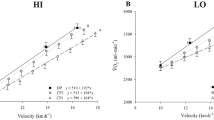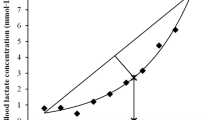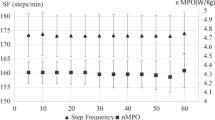Abstract
Objective
This study aimed to verify the influence of performance level on the relationship between peak velocity (Vpeak) and time limit (tlim) at 100% Vpeak.
Methods
Fifty-four male participants aged between 20 and 35 years were divided into three groups: low fitness (LF) individuals, moderate fitness (MF), and high fitness (HF). The participants performed two running tests on a treadmill: one maximal incremental test to determine Vpeak and one rectangular test to determine tlim at 100% Vpeak. Heart rate (HR) and rating of perceived exertion (RPE) were measured during the tests.
Results
For the variables evaluated during the incremental test to determine Vpeak, higher values of Vpeak were observed for HL compared to the LF (P < 0.05) and MF (P < 0.05); Vpeak for MF was significantly higher than that for LF (P < 0.05), while RPEmax for HF and MF was higher than that for LF. Regarding the test for determining tlim at 100% Vpeak, no intergroup differences were found for HRmax or tlim at 100% Vpeak. RPEmax was lower for HF than for LF and MF individuals. No correlations were found between Vpeak and tlim in any of the analyzed groups.
Conclusion
There were no associations between Vpeak and tlim at 100% Vpeak in any group; moreover, performance level did not influence tlim values.

Similar content being viewed by others
References
Billat VL, Hill DW, Pinoteau J, Petit B, Koralsztein JP (1996) Effect of protocol on determination of velocity at VO2max and on its time to exhaustion. Arch Physiol Biochem 104:313–321. https://doi.org/10.1076/apab.104.3.313.12908
Midgley AW, McNaughton LR, Jones AM (2007) Training to enhance the physiological determinants of long-distance running performance. Sports Med 37:857–880. https://doi.org/10.2165/00007256-200737100-00003
Marcora SM, Bosio A, De Morree HM (2008) Locomotor muscle fatigue increases cardiorespiratory responses and reduces performance during intense cycling exercise independently from metabolic stress. Am J Physiol Regul Integr Comp Physiol 294:874–883. https://doi.org/10.1152/ajpregu.00678.2007
Mclaughlin JE, Howley ET, Bassett JRDR, Thompson DL, Fitzhugh EC (2010) Test of classic model for predicting endurance running performance. Med Sci Sports Exerc 42:991–997. https://doi.org/10.1249/MSS.0b013e3181c0669d
Machado FA, Kravchychyn AC, Peserico CS, da Silva DF, Mezzaroba PV (2013) Incremental test design, peak ‘aerobic’ running speed and endurance performance in runners. J Sci Med Sport 16:577–582. https://doi.org/10.1016/j.jsams.2012.12.009
Peserico CS, Zagatto AM, Machado FA (2014) Reliability of peak running speeds obtained from different incremental treadmill protocols. J Sports Sci 32:993–1000. https://doi.org/10.1080/02640414.2013.876087
Peserico CS, Zagatto AM, Machado FA (2015) Evaluation of the best-designed graded exercise test to assess peak treadmill speed. Int J Sports Med 36:1–6. https://doi.org/10.1055/s-0035-1547225
Da Silva DF, Simões HG, Machado FA (2015) vVO2max versus Vpeak, what is the best predictor of running performances in middle-aged recreationally-trained runners? Sci Sports 30:e85–e92. https://doi.org/10.1016/j.scispo.2014.10.006
Renoux JC, Petiti B, Billat VL, Koralsztein JP (1999) Oxygen deficit is related to the exercise time to exhaustion at maximal aerobic speed in middle distance runners. Arch Physiol Biochem 107:280–285. https://doi.org/10.1076/13813455199908107041QFT280
Bertuzzi RC, Bueno S, Pasqua LA, Acquesta FM, Batista MB, Roschel H, Kiss MA, Serrão JC, Tricoli V, Ugrinowitsch C (2012) Bioenergetics and neuromuscular determinants of the time to exhaustion at velocity corresponding to VO2max in recreational long-distance runners. J Strength Cond Res 26:2096–2102. https://doi.org/10.1519/JSC.0b013e31823b8721
Da Cruz VHM, Peserico CS (2017) Machado FA (2017) Effect or prior warm-up duration on the time limit at peak speed in untrained men. J Sports Med Phys Fitness 57:1276–1281. https://doi.org/10.23736/S0022-4707.17.06810-4
Kimura GHS, Manoel AM, Figueiredo DH, Peserico CS, Machado (2019) Time limit at peak speed without prior warm-up: effects on test duration, heart rate and rating of perceived exertion. Arch Med Deporte 36:74–78
Da Silva DF, Ferraro ZM, Adamo KB, Machado FA (2019) Endurance running training individually-guided by Hrv in untrained women. J Strength Cond Res 33:736–746. https://doi.org/10.1519/JSC.0000000000002001
Manoel FA, da Silva DF, de Lima JRP, Machado FA (2017) Peak velocity and its time limit are as good as the velocity associated with VO2max for training prescription in runners. Sports Med Int Open 1:E8–E15. https://doi.org/10.1055/s-0042-119951
Billat VL, Flechet B, Petit B, Muriaux G, Koralsztein JP (1999) Interval training at VO2max: effects on aerobic performance and overtraining markers. Med Sci Sports Exerc 31:156–163. https://doi.org/10.1097/00005768-199901000-00024
Smith TP, Mcnaughton LR, Marshall KJ (1999) Effects of 4-week training using Vmax/Tmax on VO2max and performance in athletes. Med Sci Sports Exerc 31:892–896. https://doi.org/10.1097/00005768-199906000-00019
Smith TP, Coombes JS, Geraghty DP (2003) Optimising high-intensity treadmill training using the running speed at maximal O2 uptake and the time for which this can be maintained. Eur J Appl Physiol 89:337–343. https://doi.org/10.1007/s00421-003-0806-6
Borresen J, Lambert MI (2008) Autonomic control of heart rate during and after exercise: measurements and implications for monitoring training status. Sports Med 38:633–646. https://doi.org/10.2165/00007256-200838080-00002
Billat VL, Renoux JC, Pinoteau J, Petit B, Koralsztein JP (1994) Times to exhaustion at 100% of velocity at VO2max and modeling of the time-limit/velocity relationship in elite long-distance runners. Eur J Appl Physiol 69:271–273. https://doi.org/10.1007/bf01094801
Billat V, Renoux JC, Pinoteau J, Petit B, Koralsztein JP (1994) Reproducibility of running time to exhaustion at VO2max in subelite runners. Med Sci Sports Exerc 26(2):254–257. https://doi.org/10.1249/00005768-199402000-00018
Billat V, Bernard O, Pinoteau J, Petit B, Koralsztein JP (1994) Time to exhaustion at VO2max and lactate steady state velocity in sub elite long-distance runners. Arch Int Physiol Biochem Biophys 102:215–219
De Castro TF, Manoel FA, Figueiredo DH, Figueiredo DH, Machado FA (2019) Effect of beetroot juice supplementation on 10-km performance in recreational runners. Appl Physiol Nutr Metab 44:90–94. https://doi.org/10.1139/apnm-2018-0277
Jackson AS, Pollock ML (1978) Generalized equations for prediting body density of men. Br J Nutr 40:497–504. https://doi.org/10.1079/BJN19780152
Siri WE (1961) Tecniques for measuring body composition. National Academy Press, Washington
Jones AM, Doust JH (1996) A 1 % treadmill grade most accurately reflects the energetic cost of outdoor running. J Sports Sci 14:321–327. https://doi.org/10.1080/02640419608727717
Kuipers H, Rietjens G, Verstappen F, Schoenmakers H, Hofman G (2003) Effects of stage duration in incremental running tests on physiological variables. Int Jl of Sports Med 24:486–491. https://doi.org/10.1055/s-2003-42020
Peserico PS, Zagato AM, Machado FA (2014) Reliability of peak running speeds obtained from different incremental treadmill protocols. J Sports Sci 32:993–1000. https://doi.org/10.1080/02640414.2013.876087
Borg GA (1982) Psychophysical bases of perceived exertion. Med Sci Sports Exerc 14:377–381. https://doi.org/10.1249/00005768-198205000-00012
Hopkins W, Marshall S, Batterham A, Hanin J (2009) Progressive statistics for studies in sports medicine and exercise science. Med Sci Sports Exerc 41:3–13. https://doi.org/10.1249/MSS.0b013e31818cb278
Noakes TD, Myburgh KH, Schall R (1990) Peak treadmill running velocity during the VO2max test predicts running performance. J Sports Sci 8:35–45. https://doi.org/10.1080/02640419008732129
Morgan DW, Martin PE, Krahenbuhl GS, Baldini FD (1991) Variability in running and mechanics among trained male runners. Med Sci Sports Exerc 23:378–383. https://doi.org/10.1249/00005768-199103000-00018
Zagatto AM, Nakamura FY, Milioni F, Miyagi WE, De Poli RAB, Padulo J, Bragazzi NL, Papoti M (2017) The sensitivity of the alternative maximal accumulated oxygen deficit method to discriminate training status. J Sports Sci in 35:2453–2460. https://doi.org/10.1080/02640414.2016.1273539
Kachouri M, Vandewalle H, Huet M, Thomaidis M, Jousselin E, Monod H (1996) Is the exhaustion time at maximal aerobic speed an index of aerobic endurance? Arch Physiol Biochem 104:330–336. https://doi.org/10.1076/apab.104.3.330.12901
Hill DW, Rowell AL (1996) Running velocity at VO2max. Med Sci Sport Exerc 28:114–119. https://doi.org/10.2165/00007256-199622020-00004
Esfarjani F, Laursen PB (2007) Manipulating high-intensity interval training: effects on VO2max, the lactate threshold and 3000 m running performance in moderately trained males. J Sci Med Sport 10:27–35. https://doi.org/10.1016/j.jsams.2006.05.014
Manoel FA, Figueiredo DH, Machado FA (2018) Can the endurance training change the pacing strategy during 10 km running performance? Int J Perform Anal Sport 18:127–136. https://doi.org/10.1080/24748668.2018.1454744
Acknowledgements
This study was financed in part by the Coordenação de Aperfeiçoamento de Pessoal de Nível Superior—Brasil (CAPES)—Finance Code 001.
Author information
Authors and Affiliations
Contributions
All authors contributed to the study and design, participated to acquisition of the data, analysis and interpretation of the data and writing the text. All authors have read and approved the final version of the manuscript.
Corresponding author
Ethics declarations
Conflict of interest
The authors declare that they have no conflict of interest.
Ethical approval
The protocol was approved by the Local Human Research Ethics Committee (#623.581/2014; #409.162/2013) and appropriate standards for human experimentation have been followed.
Informed consent
Prior to testing, written informed consent was obtained from all participants and all procedures and test protocols were explained individually for each participant.
Additional information
Publisher's Note
Springer Nature remains neutral with regard to jurisdictional claims in published maps and institutional affiliations.
Rights and permissions
About this article
Cite this article
Manoel, F.A., Figueiredo, D.H., Figueiredo, D.H. et al. Association between peak velocity and time limit across different endurance performance levels. Sport Sci Health 16, 653–660 (2020). https://doi.org/10.1007/s11332-020-00638-2
Received:
Accepted:
Published:
Issue Date:
DOI: https://doi.org/10.1007/s11332-020-00638-2




